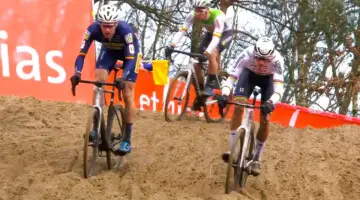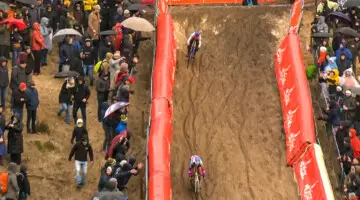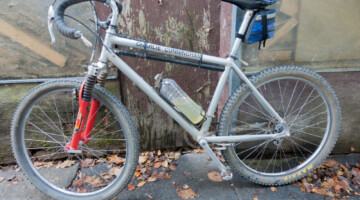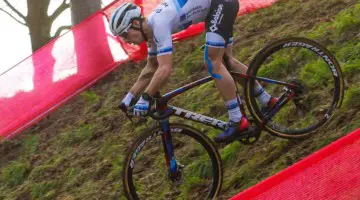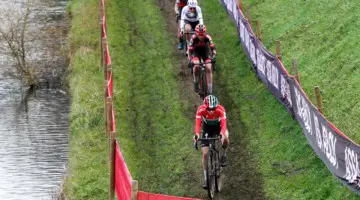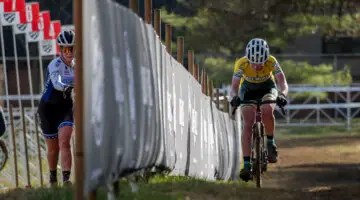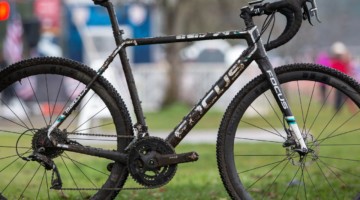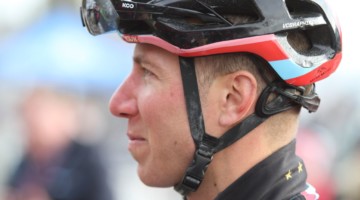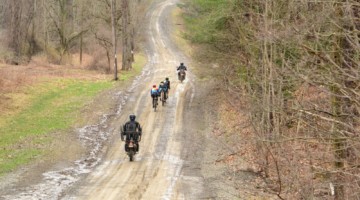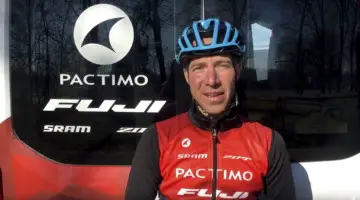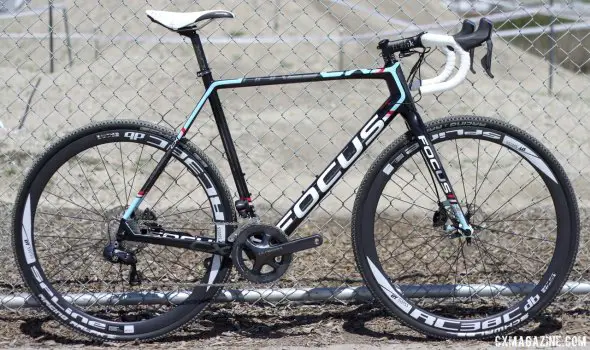
Focus’ 2015 Mares cyclocross bike increases top tube and head tube lengths, bb height. © Cyclocross Magazine
Focus and Jeremy Powers have had quite a bit of success together since the 2014 National Champion switched from Cannondale p/b CyclocrossWorld to Rapha-Focus three seasons ago, and the two parties will remain a team for the 2014/2015 season. However both parties will be going against the grain this season with their recent moves.
Focus will be bucking the trends of lowering bottom bracket heights and going completely disc brake on its framesets, and Powers will eschew the powerhouse team and instead fly solo with a one-man race program, after racers like Ryan Trebon and Ben Berden abandoned similar programs in favor of a larger team. That’s right, the Rapha-Focus team you saw last year is no more, and racers like Zach McDonald and Gabby Day will be racing this season under different colors. For followers of our off-season coverage, that’s not a huge surprise after Powers’ comments in our earlier interview.

Powers will be racing Focus 2015 Mares cyclocross bike, but won’t reveal whether it will be a disc or canti model. © Cyclocross Magazine
At Sea Otter 2014, Cyclocross Magazine spent a bit of time with both Focus and Jeremy Powers, which was easy to do as the 2014 National Champion spent some time working the Focus booth. We were lucky to have Powers and three-time Cyclocross World Champion Mike Kluge take us through the updated 2015 Focus Mares cyclocross bikes, a long-awaited update after Powers won National Championships in 2012 and 2014 on virtually the exact same frame and build. Some of the changes follow recent trends of getting lighter, stiffer and adopting thru axles (front and rear in the Mares’ case). Focus is also adding two more sizes, in the form of a 48cm and a 60cm.
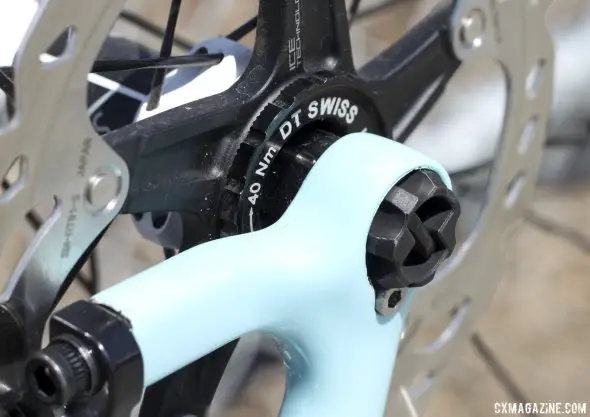
Focus 2015 Mares’ RAT front thru axle should offer relatively fast wheel changes. © Cyclocross Magazine
While the company had not locked down the spec of its 2015 bikes, it was showing off several different builds of the new Mares, with both disc and cantilever brakes, and will offer both brake options for 2015. The new Mares reportedly shed a whopping 500 grams over the previous version, and the new frame is listed at an impressive 895g without hardware. Where did the weight savings come from? Kluge says it was mostly from a refined layup and the new monocoque, thru axle fork.
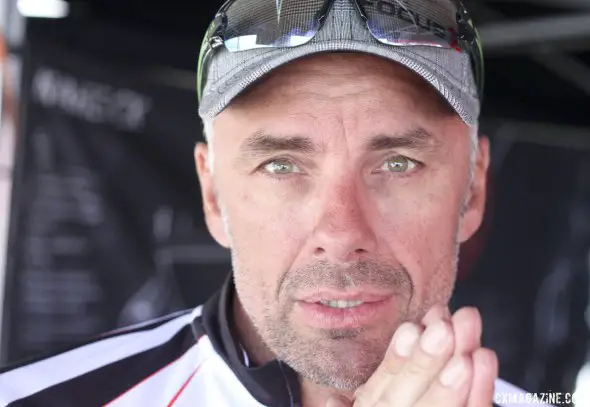
Focus’ 2015 Mares cyclocross bike benefited from Kluge’s world championship experience. © Cyclocross Magazine
Kluge showed us a cantilever model built with SRAM Red and Avid Shorty Ultimate brakes and carbon tubular wheels. “The total weight of this bike is 6.6kg…so you’re actually in trouble with the UCI because they allow only 6.8kg,” Kluge said. “So you have to eat a little bit before [the race], but in America with Dunkin’ Donuts, it’s no problem,” the former World Champion joked.
At first glance, the obvious changes to the new model are thru axles front and rear, a taller head tube, and a massive metal plate inboard of the inner chainring that protects the frame and is designed to keep the chain on in bumpy and muddy conditions.
The 15mm front thru axle and 142mm rear thru axle both feature Focus’ RAT (Rapid Axle Technology) system that utilizes a T-pin system to provide quick release-speeds in removing wheels, with the security and stiffness of thru axles. While most thru axle proponents cite better steering precision and stiffness as the key benefits, Kluge really likes the thru axle technology because of its safety benefits, and told us that if he had such technology when he was racing, he would have been able to avoid some front fork-related crashes and injuries.
The thru axles (see Issue 24’s “Cutting Thru the Hype”) aim to provide better lateral stiffness, especially in hard cornering, but the common complaint, beyond requiring new equipment, is slow wheel changes. Kluge says Focus’ RAT thru axle system is the fastest in the industry, and his demonstration (see the video at the bottom of this post) showed that a wheel can be removed with just a quick twist of the thru axle lever.
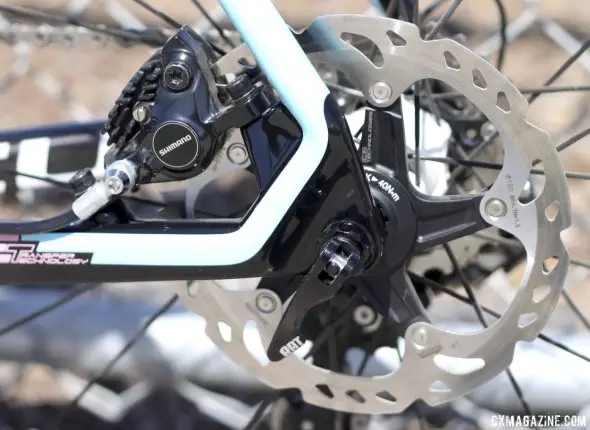
Focus’ 2015 Mares cyclocross bike features front and rear RAT thru axles, but offer quicker wheel changes. © Cyclocross Magazine
The most eye-catching change seen on the 2015 Focus Mares cyclocross bike was the integrated Focus CX Chain Guide, perhaps due its brilliant shine in the sun. The giant aluminum plate sits just inboard of the inner chainring, and utilizes the mountain bike standard ISCG-05 mounting system. The mount relies on three bolts to the bottom bracket shell, and offers a bit of rotational adjustment to match different ring sizes. We asked Kluge about use of the CX Chain Guide in 1X setup with a normal ring, and he said you could use spacers to move the guide closer to a single ring. The entire setup is said to weigh just 48g including screws.
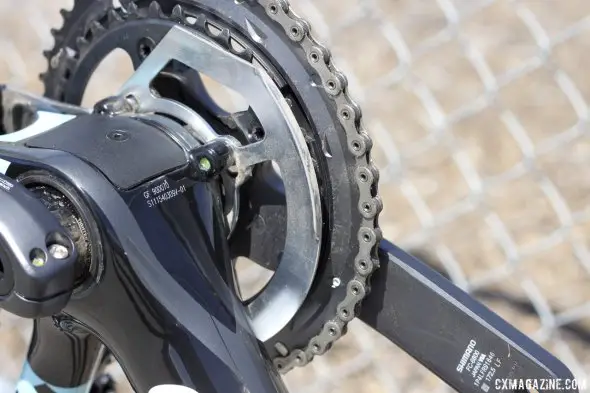
Focus’ 2015 Mares cyclocross bike with easy-access internally-routed cables and wires, and a massive inboard chainguard. © Cyclocross Magazine
Weight savings, thru axles and chain guards may be attractive for some, but Powers was most excited about the new geometry, and had a big role in some of the changes. “I worked with everyone in Germany, we talked a lot about the geometry, and the different things I was hoping to see in the bike,” he told Cyclocross Magazine.
Read on to learn more about the geometry changes (along with more photos and a Jeremy Powers video).







